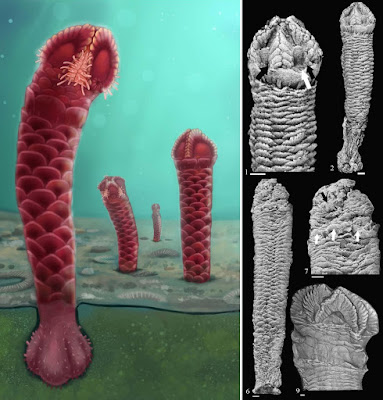 |
Rhenopyrgus viviani Ewin, Martin, Isotalo & Zamora, 2020
Silurian (lower Telychian), Jupiter Formation, Anticosti Island, Canada.
(1, 2) Rhenopyrgus grayae (Bather, 1915), Upper Ordovician, Ayrshire, Scotland
(holotype E23470); (6–7) Rhenopyrgus indet. 3; (9) Rhenopyrgus coronaeformis Rievers, 1961, Lower Devonian, Bavaria, Germany (holotype SNSB-BSPG 1958 XV 50)
DOI: 10.1017/jpa.2019.65
|
Abstract
Rhenopyrgids are rare, turreted edrioasterid edrioasteroids from the lower Paleozoic with a distinctive and apparently conservative morphology. However, new, well-preserved rhenopyrgid edrioasteroid material from Canada, along with a review of described taxa, has revealed broader structural diversity in the oral surface and enabled a re-evaluation of rhenopyrgid functional morphology and paleoecology.
The floor plates in Rhenopyrgus viviani n. sp., R. coronaeformis Rievers, 1961 and, R. flos Klug et al., 2008 are well fused to each other and the interradial oral plate and lack obvious sutures, thereby forming a single compound interradial plate. This differs from other rhenopyrgids where sutures are more apparent. Such fused oral surface construction is only otherwise seen in some derived edrioblastoids and in the cyathocystids, suggesting homoplasy.
Our analysis further suggests that the suboral constriction could contract but the flexible pyrgate zone could not. Thus, specimens apparently lacking a sub-oral constriction should not necessarily be placed in separate genera within the Rhenopyrgidae. It also supports rhenopyrgids as epifaunal mud-stickers with only the bulbous, textured, entire holdfasts (coriaceous sacs) anchored within the substrate rather than as burrow dwellers or encrusters.
Rhenopyrgus viviani n. sp. is described from the Telychian (lower Silurian) Jupiter Formation of Anticosti Island, Québec, Canada and is differentiated by a high degree of morphological variability of pedunculate plates, broader oral plates, and narrower distal ambulacral zones. Specimens lacking or with obscured diagnostic plates from the Ordovician of Montagne Noire, France, and the Ordovician and Silurian of Girvan, Scotland are also described.
Systematic paleontology
Phylum Echinodermata de Bruguière, 1791 (ex. Klein, 1734)
Class Edrioasteroidea Billings, 1858
Order Edrioasterida Bell, 1976
Suborder Edrioblastoidina Fay, 1962
Family Rhenopyrgidae Holloway and Jell, 1983
Genera included.— Rhenopyrgus Dehm, 1961; Heropyrgus Briggs et al., 2017.
Genus Rhenopyrgus Dehm, 1961
Type species.— Pyrgocystis (Rhenopyrgus) coronaeformis
Rievers, 1961; Hunsrück Slate, Lower Devonian, (Emsian) of
Germany.
Other species.— Rhenopyrgus coronaeformis Rievers, 1961;
R. flos Klug et al., 2008; R. viviani n. sp.; R. sp. indet.1,
formerly Pyrgocystis procera (Aurivillius) Bather, 1915;
R. sp. indet. 2, R. sp. indet. 3, R. sp. indet. 4.; R. grayae (Bather, 1915); R. whitei Holloway and Jell, 1983; and
R. piojoensis Sumrall et al., 2013.
Rhenopyrgus viviani new species
Occurrence.— Cybèle Member to Pavillon Member, Jupiter
Formation, Telychian, upper Llandovery, lower Silurian,
Anticosti Island, Québec, Canada.
Etymology.— Named for the initial discoverer Mr. Travis
Vivian.
Timothy A. M. Ewin, Markus Martin, Phillip Isotalo and Samuel Zamora. 2020. New Rhenopyrgid Edrioasteroids (Echinodermata) and Their Implications for Taxonomy, Functional Morphology, and Paleoecology. Journal of Paleontology. 94(1); 115-130. DOI: 10.1017/jpa.2019.65
Newest member of echinoderm family revealed


